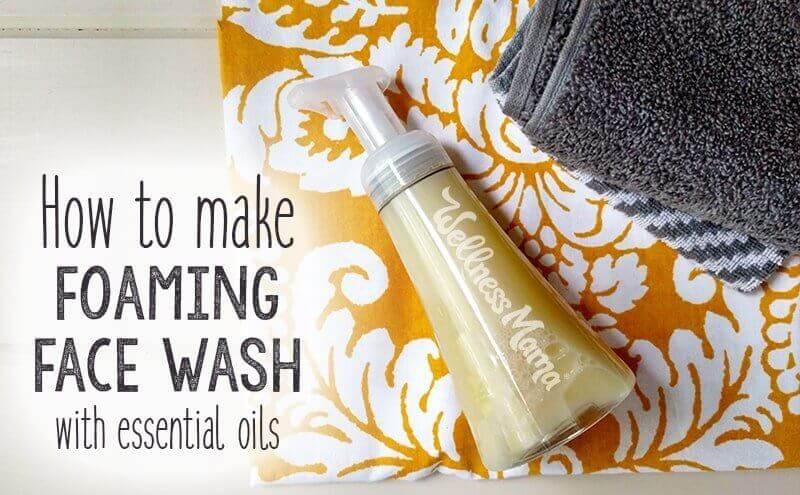I’m a big fan of the oil cleansing method, and I’ve even been known to rub raw honey on my face. For those who are looking for a more traditional soap-based way to cleanse skin, I’ve been experimenting with this foaming face wash recipe. It has a rich lather and benefits every skin type.
This recipe is very similar to my foaming hand soap with a little added boost of skin nourishment from various hydrosols. While you can use distilled water as a more frugal option, hydrosols have a much longer shelf life than water and have extra benefits.
Hydrosols in Foaming Face Wash
Hydrosols are the by-product of essential oil production. While essential oils are highly concentrated, hydrosols are very gentle, but with many of the same properties.
One big difference to note: hydrosols are water soluble and essential oils are not. This makes mixing easier and takes away some of the worries about using essential oils safely.
Depending on how it’s made and what preservatives are used, hydrosols will typically last 12-18 months. This is a benefit to homemade skincare products since they typically don’t contain preservatives and can spoil earlier than shelf-stable commercial products.
How to Choose a Hydrosol by Skin Type
- Witch hazel hydrosol – This is different from the witch hazel found in most stores which contains alcohol. It’s an astringent and cleansing, making it good for oily and acne-prone skin.
- Rose hydrosol – This hydrosol is soothing and nourishing for all skin types, but it’s especially good for mature skin. Rose is hydrating and a humectant to lock in moisture.
- Chamomile hydrosol – Very calming to irritated skin. Chamomile hydrosol improves skin elasticity and is antiseptic, and antibacterial.
- Cucumber hydrosol – Useful for all skin types, this hydrosol cools and calms inflamed skin. It’s also very hydrating.
- Clary sage hydrosol– This is a more potent-smelling hydrosol, but it’s known to smooth and calm skin. It’s also slightly astringent so it’s perfect for oily skin.
- Geranium hydrosol – Geranium hydrosol is good for all skin types but particularly aging skin. It’s soothing, anti-inflammatory, and balancing.
Foaming Face Wash with Essential Oils
The beauty of a DIY face wash (pun intended!) is that you can swap out ingredients depending on specific skin conditions for a completely customized face wash. In a hydrosol the essential oils are diluted to about 2%, and the dilutions should be kept to 1-5% to avoid skin irritation. Keep this in mind if substitutions are being made.
A note on castile soap in recipes … different brands have different consistencies, so the amounts may need adjusting. The Dr. Bronners brand of castile soap is very thick, while some other brands are less so. Try reducing the hydrosol (or distilled water in the budget version) by half if the soap seems runny.
Foaming Face Wash for Oily or Acne Prone Skin
- 8 oz foaming dispenser
- 2/3 cup castile soap
- 40 drops tea tree essential oil
- 40 drops lavender essential oil
- 1/3 cup witch hazel hydrosol or clary sage hydrosol (OR distilled water)
- 2 tsp rosehip seed oil
Foaming Face Wash for Aging or Blemished Skin
Ingredients
- 8 oz foaming dispenser
- 2/3 cup castile soap
- 20 drops frankincense essential oil
- 40 drops lavender essential oil
- 20 drops lemon essential oil *see safety note below
- 1/3 cup rose hydrosol chamomile or carrot seed hydrosol (OR distilled water)
- 2 tsp avocado oil
Foaming Face Wash for Normal Skin
Ingredients
- 8 oz foaming dispenser
- 2/3 cup castile soap
- 20 drops patchouli essential oil
- 45 drops sweet orange essential oil
- 1/3 cup cucumber hydrosol or geranium hydrosol OR distilled water
- 2 tsp sweet almond oil
Instructions
- In the soap dispenser add the essential oil, castile soap, and carrier oil. Swirl the bottle until the ingredients are well combined.
- Add the distilled water or the hydrosol, leaving at least 1 inch of space at the top for the pump. You may not need a full ¼ cup to fill it. If the castile soap is thin, then reduce the hydrosol or water to 1/4 cup.
- Cap the dispenser tightly and gently tip it back and forth to mix everything. Don’t shake it too much though or there will be a bunch of suds!
Safety Note
Lemon essential oil is phototoxic if used above 2% in a leave-on product like a lotion. Just leave it out if desired, but you’ll miss out on its cleansing and age spot lightening benefits. I consider this recipe safe since it uses it at only 1% and it’s washed off. If there is any concern, use the face wash at night or at least 12 hours before sun exposure.
What is your skincare routine? Ever tried a foaming face wash? Share below!




Leave a Reply